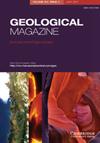阿德莱德超级盆地斯特期冰川作用的地质年代和形式地层学
IF 2
3区 地球科学
Q3 GEOSCIENCES, MULTIDISCIPLINARY
引用次数: 2
摘要
摘要Yudnamutana亚群的冰川成因性质在一个多世纪前首次得到承认,其全球意义在不久后得到承认,最终提出了全球斯特冰川作用和雪球地球理论。自那以后的几年里,关于这些岩石的起源和时间,当地和全球都发生了很多争论。全球范围内对这些层序的岩性、沉积学、地质年代学和正式岩石地层学的大量研究试图解决其中的许多争论。在南澳大利亚的阿德莱德超级盆地Sturtian冰川作用的类型区,岩石地层学和沉积学得到了很好的了解;然而,正式的地层命名法仍然是复杂和有争议的。该地区地层上的绝对日期也极为稀少。这些长期存在的问题的结果是,对于Yudnamutana亚群的沉积岩是否在整个南澳大利亚州都具有真正的相关性,以及它们是否在最近为全球Sturtian冰川岩定义的同一时间跨度内沉积(约717 Ma至约660 Ma),一直存在分歧,总结和汇编了Sturtian冰川作用的现有全球地质年代,并修订了Yudnamutana亚群的正式岩石地层框架。我们展示了构成修正后的斯特组(Yudnamutana亚群的主要冰川成因单元)的岩石的等效性,以及它是在全球为斯特期冰川作用定义的时间跨度内沉积的。本文章由计算机程序翻译,如有差异,请以英文原文为准。
Geochronology and formal stratigraphy of the Sturtian Glaciation in the Adelaide Superbasin
Abstract The glaciogenic nature of the Yudnamutana Subgroup was first recognized over a century ago, and its global significance was recognized shortly after, with the eventual postulation of a global Sturtian Glaciation and Snowball Earth theory. Much debate on the origin and timing of these rocks, locally and globally, has ensued in the years since. A significant corpus of research on the lithology, sedimentology, geochronology and formal lithostratigraphy of these sequences globally has attempted to resolve many of these debates. In the type area for the Sturtian Glaciation, South Australia’s Adelaide Superbasin, the lithostratigraphy and sedimentology are well understood; however, formal stratigraphic nomenclature has remained complicated and contested. Absolute dates on the stratigraphy are also extremely sparse in this area. The result of these longstanding issues has been disagreement as to whether the sedimentary rocks of the Yudnamutana Subgroup are truly correlative throughout South Australia, and if they were deposited in the same time span recently defined for Sturtian glacial rocks globally, c. 717 Ma to c. 660 Ma. This study presents a large detrital zircon study, summarizes and compiles existing global geochronology for the Sturtian Glaciation and revises the formal lithostratigraphic framework of the Yudnamutana Subgroup. We show equivalence of the rocks that comprise the revised Sturt Formation, the main glaciogenic unit of the Yudnamutana Subgroup, and that it was deposited within the time span globally defined for the Sturtian Glaciation.
求助全文
通过发布文献求助,成功后即可免费获取论文全文。
去求助
来源期刊

Geological Magazine
地学-地球科学综合
CiteScore
4.70
自引率
0.00%
发文量
111
审稿时长
3 months
期刊介绍:
Geological Magazine, established in 1864, is one of the oldest and best-known periodicals in earth sciences. It publishes original scientific papers covering the complete spectrum of geological topics, with high quality illustrations. Its worldwide circulation and high production values, combined with Rapid Communications and Book Review sections keep the journal at the forefront of the field.
This journal is included in the Cambridge Journals open access initiative, Cambridge Open Option.
 求助内容:
求助内容: 应助结果提醒方式:
应助结果提醒方式:


